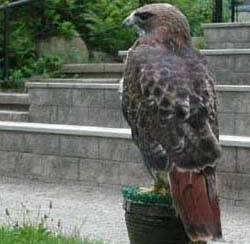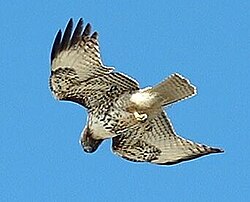Difference between revisions of "Field Guide/Birds/Buteo jamaicensis"
(+fr:) |
(added "birds" category) |
||
| Line 46: | Line 46: | ||
|} | |} | ||
| + | [[Category:Birds]] | ||
[[Category:Birds of prey]] | [[Category:Birds of prey]] | ||
[[fr:Buse à queue rousse]] | [[fr:Buse à queue rousse]] | ||
Revision as of 22:22, 28 April 2005
| Red-tailed Hawk | ||||||||||||||
|---|---|---|---|---|---|---|---|---|---|---|---|---|---|---|
 | ||||||||||||||
| Scientific Classification | ||||||||||||||
| ||||||||||||||
| Binomial name | ||||||||||||||
| Buteo jamaicensis (Gmelin, 1788) |
The Red-tailed Hawk, Buteo jamaicensis, is a large North American hawk.
Birds of this species have a dark mark along the leading edge of the underwing, between the body and the wrist (the patagium). Most but not all colour variations have a dark band across the belly. In most, adults' tails above are rusty red and juveniles' have narrow brown and pale bands. The main western population has bands on the adults' rusty tails as well and has varied plumage, organized into three main colour types or morphs.
- Light-morph birds are mainly brown on the upperparts and very pale brown or buff on the underparts and underwings; they show a belly band.
- Rufous-morph birds are darker and redder, with reddish-brown rather than white on the underparts. The belly band may be barely visible.
- Dark-morph birds are very dark brown on both upperparts and underparts; they have lighter parts on the underwings.
Almost all of the main eastern population are light-morph, with whiter underparts and paler markings than western birds and with solid rust-red tails as adults.
Other variations are:
- Harlan's Hawk usually has blackish plumage contrasting with white undersides of the flight feathers; the tail may be reddish or grey and is longitudinally streaked rather than barred. It breeds in Alaska and northwestern Canada and winters from Nebraska and Iowa to Texas and northern Louisiana. It is sometimes considered a separate species, Buteo harlani.
- Krider's Hawk is paler than other red-tails, especially on the head; the tail may be pinkish or white. It is mainly found in the central prairies.
Their breeding habitat is open country with high perches across most of North America south to Panama. They build a stick nest in a large tree, in a cactus, or on a cliff ledge; they may also nest on man-made structures.
In most of the United States, Red-tailed Hawks are permanent residents. Northern birds migrate further south. Throughout their range in the U.S., red-tailed hawks receive special legal protections under the Migratory Bird Treaty Act of 1918.
These birds wait on a high perch and swoop down on prey; they may also patrol open areas in flight. They mainly eat small mammals, birds and reptiles.
In flight, these birds soar with wings in a slight dihedral, flapping as little as possible. They sometimes hover on beating wings and sometimes "kite", or remain stationary above the ground by soaring into the wind.
The Red-tailed Hawk is common and widespread, partly because it has benefited from European settlement. The clearing of trees in the east provided hunting areas, and the practice of sparing woodlots left nest sites. Conversely, the planting of trees in the west provided nest sites where there had been none. The construction of highways with treeless medians and shoulders and with utility poles alongside provided perfect habitat for perch-hunting, so Red-tailed Hawks are now a common sight along highways. Finally, these birds have moved into New York and other cities, as in the successful non-fiction book Red-Tails in Love: A Wildlife Drama in Central Park, by Marie Winn. Winn wrote about one of the most famous of them, Pale Male.
File:Red-tailed Hawk KSC00pp0245.jpg Red-tailed Hawk, perched in Florida. |
File:Redtailedhawkap.jpg Red-tailed Hawk, juvenile eastern race. |

